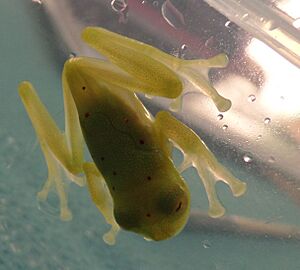Nymphargus grandisonae facts for kids
Quick facts for kids Nymphargus grandisonae |
|
|---|---|
 |
|
| Conservation status | |
| Scientific classification | |
| Synonyms | |
|
The giant glass frog or red-spotted glassfrog (scientific name: Nymphargus grandisonae) is a special type of frog. It belongs to the Centrolenidae family, which is known for its frogs often having see-through skin! You can find this frog living in the Andes mountains in Colombia and Ecuador. It loves to live in wet, tropical montane forests, also called cloud forests. Its babies, called larvae, grow up in streams and quiet pools of water. Even though its home faces threats like habitat loss and pollution, this frog is still quite common.
Contents
What Does the Giant Glass Frog Look Like?
This frog is quite small. Adult males are about 27 millimeters (about 1 inch) long. Females are a bit bigger, reaching about 30 millimeters (just over 1 inch).
Eyes and Body
The giant glass frog has large, round eyes with bright yellow irises. Its body and legs are thin. It has big sticky pads on its fingers and toes. These pads help it cling to leaves and branches.
Special Features
Male frogs have a unique hooked spur on their upper arm. They use this spur when they fight other male frogs. The top of their head and body is green. It has many small, round red spots. The underside of the frog is whitish or creamy yellow.
Where Does the Giant Glass Frog Live?
This frog lives only in Colombia and Ecuador. It is found on the western slopes of the Western Cordilleras and the Central Cordilleras in Colombia. In Ecuador, it lives in the provinces of Carchi, Cotopaxi, Pichincha, and Santo Domingo de los Tsáchilas.
Its Home
It lives at altitudes between 1,140 and 2,010 meters (about 3,740 to 6,590 feet) high in the mountains. You can find it in plants in swamps and near streams. It lives in cloud forests, at the edges of forests, in pastures, and even by roadsides. However, it always stays close to forests.
How Does the Giant Glass Frog Live and Reproduce?
The giant glass frog is active at night. It breeds in streams and pools of water.
Attracting a Mate
Male frogs gather in plants a few meters above a water body. They call out to attract females. They might call for a few days or even up to three months from their favorite spots. On average, they call for about 36 days.
Male Fights
Males sometimes fight with other males. They hang from twigs and leaves using their back legs. They use the spurs on their front legs to battle. Sometimes, they get hurt during these fights.
Laying Eggs
Scientists once watched a pair of frogs laying eggs. The male and female were on a large leaf for several hours. They moved around the leaf and to other leaves before returning to their first spot. The female then started laying eggs near the edge of the leaf. She moved forward slowly as she laid them.
When she finished, she slowly moved back. She covered the eggs with her body for 25 minutes. There were 61 eggs in this group. They were placed so that when the tadpoles hatched, they would fall right into the water below.
Is the Giant Glass Frog in Danger?
The area where this frog lives is somewhat small, about 20,000 square kilometers (about 7,700 square miles) or less.
Threats to Its Home
The main dangers it faces include:
- Deforestation: Forests are being cut down.
- Logging: Trees are being harvested.
- Introduced fish: New types of fish are put into the streams where the frogs live. These fish might eat the frog's babies.
- Pollution: Chemicals from farming activities get into the water.
Conservation Status
Even with these threats, the giant glass frog is a common and adaptable species. The International Union for Conservation of Nature (IUCN) has listed its conservation status as "least concern". This means that while its population might be decreasing, it's happening too slowly to be considered highly threatened right now.


